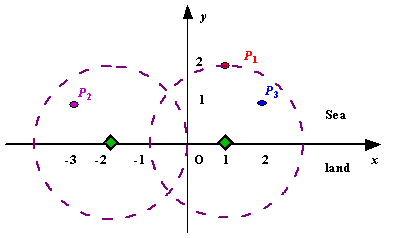Radar Installation
| Time Limit: 1000MS | Memory Limit: 10000K | |
| Total Submissions: 54211 | Accepted: 12195 |
Description
Assume the coasting is an infinite straight line. Land is in one side of coasting, sea in the other. Each small island is a point locating in the sea side. And any radar installation, locating on the coasting, can only cover d distance, so an island in the
sea can be covered by a radius installation, if the distance between them is at most d.
We use Cartesian coordinate system, defining the coasting is the x-axis. The sea side is above x-axis, and the land side below. Given the position of each island in the sea, and given the distance of the coverage of the radar installation, your task is to write a program to find the minimal number of radar installations to cover all the islands. Note that the position of an island is represented by its x-y coordinates.

Figure A Sample Input of Radar Installations
We use Cartesian coordinate system, defining the coasting is the x-axis. The sea side is above x-axis, and the land side below. Given the position of each island in the sea, and given the distance of the coverage of the radar installation, your task is to write a program to find the minimal number of radar installations to cover all the islands. Note that the position of an island is represented by its x-y coordinates.

Figure A Sample Input of Radar Installations
Input
The input consists of several test cases. The first line of each case contains two integers n (1<=n<=1000) and d, where n is the number of islands in the sea and d is the distance of coverage of the radar installation. This is followed by n lines each containing
two integers representing the coordinate of the position of each island. Then a blank line follows to separate the cases.
The input is terminated by a line containing pair of zeros
The input is terminated by a line containing pair of zeros
Output
For each test case output one line consisting of the test case number followed by the minimal number of radar installations needed. "-1" installation means no solution for that case.
Sample Input
3 2 1 2 -3 1 2 1 1 2 0 2 0 0
Sample Output
Case 1: 2 Case 2: 1
题意:在x轴上建立雷达,每个雷达的范围是半径为d的圆,问覆盖所有的岛屿至少需要多少雷达。
思路:对于每个岛屿,我们都可以找到在x轴上的雷达建立范围,要从左往右建的话,就首先找到右端点最小的,之后l小于这个数的都已经覆盖,如果l大于这个数的,就让答案+1,更新右端点。
AC代码如下:
#include<cstdio>
#include<cstring>
#include<algorithm>
#include<cmath>
using namespace std;
int n,d;
struct node
{
double l,r;
bool flag;
}island[1010];
bool cmp(node a,node b)
{
return a.r<b.r;
}
bool flag;
int main()
{
int t=0,i,j,k,x,y,pos,ans;
double ret,L,R;
while(~scanf("%d%d",&n,&d) && n>0)
{
flag=1;
t++;
for(i=1;i<=n;i++)
{
scanf("%d%d",&x,&y);
if(y>d)
{
flag=0;
continue;
}
island[i].l=x-sqrt((double)(d*d-y*y));
island[i].r=x+sqrt((double)(d*d-y*y));
island[i].flag=1;
}
if(!flag)
{
printf("Case %d: -1\n",t);
continue;
}
sort(island+1,island+1+n,cmp);
ans=1;
R=island[1].r;
for(i=1;i<=n;i++)
{
if(island[i].l>R)
{
ans++;
R=island[i].r;
}
}
printf("Case %d: %d\n",t,ans);
}
}







 本文介绍了一种算法问题,即如何在海岸线上设置雷达站以覆盖海中的所有岛屿,并尽可能减少雷达站的数量。通过确定每个岛屿对应的雷达覆盖区间,采用排序和贪心策略找到了最优解。
本文介绍了一种算法问题,即如何在海岸线上设置雷达站以覆盖海中的所有岛屿,并尽可能减少雷达站的数量。通过确定每个岛屿对应的雷达覆盖区间,采用排序和贪心策略找到了最优解。
















 567
567

 被折叠的 条评论
为什么被折叠?
被折叠的 条评论
为什么被折叠?








